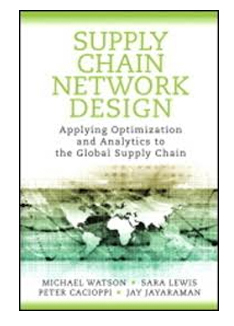Dr. Watson Says: |
 |
| ...You need to have someone running the model who understands the trade-offs between transportation, warehousing, and production... |
|
What Do You Say?
|
|
|
|
 Dan Gilmore and this column have often discussed the importance of being able to do network design in-house (here and here are two examples). Dan Gilmore and this column have often discussed the importance of being able to do network design in-house (here and here are two examples).
We even wrote a book on network design to demystify the process and allow more companies bring this art and discipline in-house.
Once you decide to start a network design group or assign a team to do this in your organization, you need to decide who is actually going to have their hands on the keyboard and build the models.
We are often asked what skills that person should have. Here are the top five skills we think you should consider:
1.
Ability to manipulate large data sets. Network design involves pulling together data from different parts of the organization—demand files, transportation files, and possibly production files. And, the same type of data (demand, for example), may come in different formats from different divisions or countries. You need someone who can work with this data, clean it, combine it, and distill it for the model. This person should be handy with Excel and, even better, know Access (or some other database).
Previous Columns by
Dr. Watson |
|
|
2. Ability to understand trade-offs in the supply chain. A network design project needs to consider the entire supply chain. You need to have someone running the model who understands the trade-offs between transportation, warehousing, and production. You need someone who understands trade-offs between different divisions or brands. And, you need someone who understands that there may be trade-offs between your customers. In other words, you need someone who is willing to look at the supply chain as a whole.
3. Ability to separate the important from the trivial. This is related to the point above. The whole supply chain is quite complicated. You need someone who can understand the complexity, but also realizes that some of the complexity does not need to be modeled. You don’t want your project to get bogged down because you are focusing on trivial aspects of the business and missing the big picture.
4. Ability to troubleshoot. Things will go wrong when you are modeling. You need someone who can troubleshoot. You should think of this in broadest sense. The modeler needs to troubleshoot the data they receive (when they get a set of data, they need to be able to understand when something important—like an entire division—is missing). The modeler also needs to troubleshoot their model (they hit run and the model returns funny results).
5. Ability to communicate the results. The results of the network model can be complicated to explain. You need a modeler who can clearly explain the results, can talk to the different groups in the supply chain, and understands how to explain the results with the right maps, charts, and tables. Also, it is important that the modeler can explain why the model is doing what it is doing and be able to pull out examples from the underlying results to show this. In other words, the modeler can’t explain the results by saying, “because that is what the model said.”
|